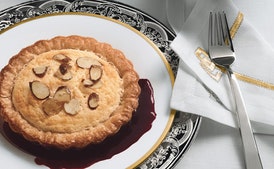
Introduction
Experience the delightful combination of tangy lemon and sweet almonds encased in a light, fluffy soufflé. These Lemon Soufflé Tartlets with Sugared Almonds and Blackberry Sauce offer an exquisite balance of flavors that cater to both sweet and savory palates.
Tips for this recipe
- Ensure your egg whites are at room temperature before whipping them to achieve the perfect, stable structure needed for a soufflé.
- Use precise measurements when adding lemon juice to avoid curdling the mixture and ensure consistent tartlet quality.
Written by: Anonymous Recipe Expert
Why you will love this recipe
The Lemon Soufflé Tartlets with Sugared Almonds and Blackberry Sauce offer a sophisticated dessert experience. The contrast between the light, airy soufflé and the rich almond crust is unparalleled. Additionally, the vibrant blackberry sauce adds a refreshing element to each bite.
Ingredients
- 1 cup plus 3 to 4 tablespoons sugar, divided
- 2 teaspoons cornstarch
- 1/2 cup fresh lemon juice
- 6 large egg yolks
- Pinch of coarse kosher salt
- 1/2 cup (1 stick) pareve margarine (such as Nucoa), diced
- 1/2 cup sliced almonds
- 1/2 tablespoon water
- 1 16-ounce bag frozen blackberries, thawed
- 1 1/3 cups all purpose flour
- 2/3 cup (packed) powdered sugar
- 1 teaspoon finely grated lemon peel
- 1/4 teaspoon salt
- 10 tablespoons (1 1/4 sticks) chilled pareve margarine (such as Nucoa), diced
- 4 large egg whites
- 1/2 teaspoon cream of tartar
- Pinch of coarse kosher salt
- 1/4 cup sugar
- Powdered sugar (optional)
Adviced equipment
- Stand Mixer: Essential for mixing batter and whipping egg whites to ensure optimal texture for soufflés.
- Silicone Baking Mats or Parchment Paper: Used for lining baking trays with an even surface that prevents sticking, crucial when handling delicate tartlets.
- Offset Spatula: Versatile tool for precisely spreading filling and ensuring even layers in the tartlet base without causing damage to the soufflé structure.
- Tartlet Molds or Ramekins: Designed molds are ideal for creating uniform tartlets, promoting consistent baking results.
- Precision Thermometer: Accurately monitors oven temperature essential when preparing a soufflé to achieve the desired rise and texture.
- Pastry Brush: For applying simple syrup or egg wash on tartlets before baking for that golden-brown finish and flavor enhancement.
History of the recipe
The origin of Lemon Soufflé Tartlets with Sugared Almonds and Blackberry Sauce can be tracited back to classic French dessert techniques. The soufflé, a staple in French cuisine, has been refined over centuries into this light-as-air concoction that highlights the interplay of flavors and textures.
The incorporation of sugared almonds is believed to be influenced by traditional European holiday fare, often enjoyed during festive seasons as a nod to historical culinary practices. The addition of blackberry sauce offers an unexpected twist that honors the fruit’s long-standing presence in global dessert traditions.
Over time, this recipe has evolved from its French roots into a versatile dish celebrated for its complexity and elegance. It continues to delight food enthusiasts who appreciate the intricate balance between simplicity and sophistication found within each bite.
Fun facts about this recipe
The Lemon Soufflé Tartlet is not just a dessert but an art form, embodying the precision and skill of French pastry chefs. It’s fascinating to note that soufflés are sometimes referred to as “the crown jewel” in culinary circles due to their challenging nature.
The use of pareve margarine is a modern twist, catering to various dietary preferences while maintaining the integrity of traditional recipes. Pareve (parve) indicates that dairy and meat are not present in food products, making it suitable for vegetarians, vegans, and those who observe kosher or halal dietary laws.
Furthermore, the practice of serving desserts such as this with a simple blackberry sauce is more than just flavorful; it’s an homage to agricultural history. Blackberries have been cultivated for thousands of years and were among some of the first fruits domesticated by humans.



